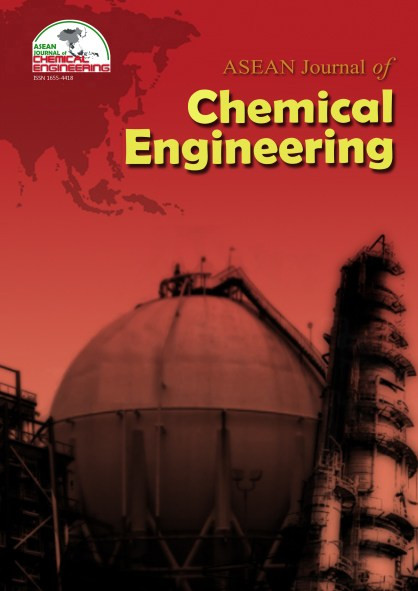Preparation and Characterization of Sulfonated Carbon Cryogel Doped Zinc as a Catalyst for Glucose Ethanolysis to Ethyl Levulinate
Abstract
In this study, sulfonated carbon cryogel (CC) doped with zinc was prepared and used as a solid catalyst. Carbon cryogel was prepared by mixing urea and furfural, freeze-drying, and calcination. The CC was then sulfonated and impregnated with zinc (II) nitrate for ethyl levulinate production from ethanolysis of glucose. Experiment results showed that different types of catalyst prepared from CC precursor had different catalytic effects on the ethanolysis of glucose. Sulfonated carbon cryogel doped with zinc (SCC-Zn) which prepared at a calcination temperature of 300 °C showed better performance as a catalyst for the ethanolysis reaction of glucose. In addition, the 10 wt.% of Zn was recommended as optimum loading for the impregnation on the catalyst. The ethyl levulinate yield of 19.6 mol% was obtained at 180 °C for 6 h with 0.15 g catalyst loading and 0.4 g of glucose feed. The selected SCC-Zn catalyst was further characterized by using FTIR, TGA XRD, and SEM-EDX to evaluate its physical and chemical properties as a catalyst.
References
2. Chang, C., Xu, G., Jiang, X. (2012). "Production of ethyl levulinate by direct conversion of wheat straw in ethanol media," Bioresource Technol., 121, 93-99.
3. Dai, J., Peng, L., Li, H. (2018). "Intensified ethyl levulinate production from cellulose using a combination of low loading H2SO4 and Al(OTf)3," Catal. Commun., 103, 116-119.
4. Fatimah, I., Yudha, S. P., Sopiana, K. D., Ratnasari, D. L. (2016). "Effect of Zn content on the physicochemical characteristics and photoactivity of ZnO supported activated carbon," Orient. J. Chem., 32(5), 2757-2768.
5. Guan, Q., Lei, T., Wang, Z., Xu, H., Lin, L., Chen, G., Li, X., Li, Z. (2018). "Preparation of ethyl levulinate from wheat straw catalysed by sulfonate ionic liquid," Ind. Crops. Prod., 113, 150-156.
6. Guo, H., Hirosaki, Y., Qi, X., Smith Jr, R. L. (2020). "Synthesis of ethyl levulinate over amino-sulfonated functional carbon materials," Renew. Energ., 157, 951-958.
7. Heda, J., Niphadkar, P., Bokade, V. (2019). "Efficient Synergetic Combination of H-USY and SnO2 for Direct Conversion of Glucose into Ethyl Levulinate (Biofuel Additive)," Energ. Fuel., 33(3), 2319-2327.
8. Joshi, H., Moser, B. R., Toler, J., Smith, W. F., Walker, T. (2011). "Ethyl levulinate: A potential bio-based diluent for biodiesel which improves cold flow properties," Biomass Bioenerg., 35(7), 3262-3266.
9. Karnjanakom, S., Bayu, A., Maneechakr, P., Samart, C., Kongparakul, S., Guan, G. (2020). "Study of a recycling reaction system for catalytic transformation of biomass-based carbohydrates via acidic-polar biphasic conditions," React. Chem. Eng., 5, 1405-1409.
10. Kaushik, M., Niranjan, R., Thangam, R., Madhan, B., Pandiyarasan, V., Ramachandran, C., Oh, D.-H., Venkatasubbu, G. D. (2019). "Investigations on the antimicrobial activity and wound healing potential of ZnO nanoparticles," Appl. Surf. Sci., 479, 1169-1177.
11. Mohammadbagheri, Z., Chermahini, A. N. (2020). “Direct production of hexyl levulinate as a potential fuel additive from glucose catalyzed by modified dendritic fibrous nanosilica,” Renew. Energ., 147, 2229-2237.
12. Morales, G., Osatiashtiani, A., Hernández, B., Iglesias, J., Melero, J. A., Paniagua, M., Brown, D. R., Granollers, M., Lee, A. F., Wilson, K. (2014). “Conformal sulfated zirconia monolayer catalysts for the one-pot synthesis of ethyl levulinate from glucose,” Chem. Commun., 50, 11742-11745.
13. Peng, L., Lin, L., Zhang, J., Shi, J., Liu, S. (2011). “Solid acid catalyzed glucose conversion to ethyl levulinate,” Appl. Catal. A-Gen., 397, 259-265.
14. Ramli, N. A. S., Amin, N. A. S. (2015). "Fe/HY zeolite as an effective catalyst for levulinic acid production from glucose: characterization and catalytic performance," Appl. Catal. B-Environ., 163, 487-498.
15. Rocha, P. D., Oliveira, L. S., Franca, A. S. (2019). "Sulfonated activated carbon from corn cobs as heterogeneous catalysts for biodiesel production using microwave-assisted transesterification," Renew. Energ., 143, 1710-1716.
16. Song, D., Zhang, Q., Sun, Y., Zhang, P., Guo, Y. H., Hu, J. L. (2018). "Design of ordered mesoporous sulfonic acid functionalized ZrO2/organosilica bifunctional catalysts for direct catalytic conversion of glucose to ethyl levulinate," ChemCatChem, 10(21), 4953-4965.
17. Zainol, M. M., Amin, N. A. S., Asmadi, M. (2017). "Effects of thermal treatment on carbon cryogel preparation for catalytic esterification of levulinic acid to ethyl levulinate," Fuel Process. Technol., 167, 431-441.
18. Zainol, M. M., Asmadi, M., Iskandar, P., Wan Ahmad, W. A. N., Amin, N. A. S., Hoe, T. T. (2021). “Ethyl levulinate synthesis from biomass derivative chemicals using iron doped sulfonated carbon cryogel catalyst,” J. Clean. Prod., 281, 124686.
19. Zainol, M. M., Nazreen, W. A., Ylang, P. I. P., Hoe, T. T., Yussuf, M. A. M., Amin, N. A. S. (2020). "Ethyl Levulinate Synthesis from Levulinic Acid and Furfuryl Alcohol by Using Modified Carbon Cryogel," Chem. Eng. Trans., 78, 547-552.
20. Zhang, J., Chen, J. (2016). "Modified solid acids derived from biomass based cellulose for one-step conversion of carbohydrates into ethyl levulinate," J. Energy Chem., 25(5), 747-753.
21. Zhang, Z., Yuan, H. (2020). "An alumina‐coated UiO‐66 nanocrystalline solid superacid with high acid density as a catalyst for ethyl levulinate synthesis," J. Chem. Technol. Biotechnol., 95(11), 2930-294
Copyright holder for articles is ASEAN Journal of Chemical Engineering. Articles published in ASEAN J. Chem. Eng. are distributed under a Creative Commons Attribution-NonCommercial 4.0 International (CC BY-NC 4.0) license.
Authors agree to transfer all copyright rights in and to the above work to the ASEAN Journal of Chemical Engineering Editorial Board so that the Editorial Board shall have the right to publish the work for non-profit use in any media or form. In return, authors retain: (1) all proprietary rights other than copyright; (2) re-use of all or part of the above paper in their other work; (3) right to reproduce or authorize others to reproduce the above paper for authors’ personal use or for company use if the source and the journal copyright notice is indicated, and if the reproduction is not made for the purpose of sale.



